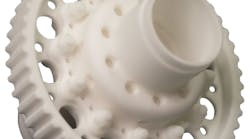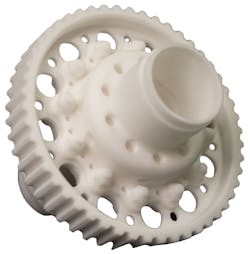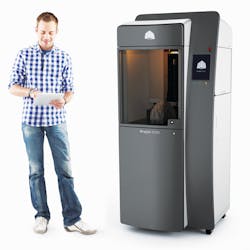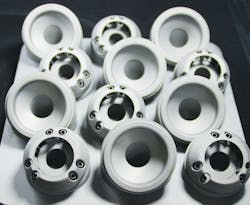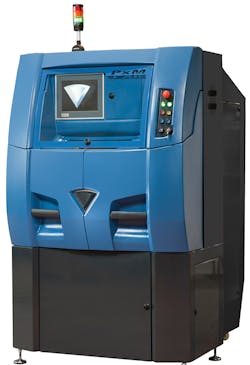How designers can get the most out of additive manufacturing
We all know the various taglines and claims being attached to additive manufacturing (AM). For instance, we hear that AM makes new designs and products possible. And that’s true. AM lets engineers create products and components that couldn’t be made any other way: complex, organic designs; unique, intricate assemblies; and one-off pieces for which tooling would be cost prohibitive.
But many manufacturers still wonder what, if anything, AM means to them. With all the AM technologies in use, how can they ensure they’ve selected the right one?
The key is to know as much as possible about AM technologies. All too often, managers rely on old or incomplete information. But the AM from just five years ago is by no means today’s technology. Take materials, for instance. They were once considered subpar for functional end-use parts, and they often were. AM materials are now used to make end-use parts and have proven viable alternatives to many traditional materials. At the same time, AM materials are coming down in cost, build platforms that dictate the size of finished parts are growing, precision and surface finish are improving, and AM methods are more finely tuned.
So let’s take a closer look at current AM technologies, their capabilities, and benefits they bring to traditional manufacturing.
Selective-laser sintering
In selective-laser sintering (SLS), a laser hardens and bonds small grains of plastic, ceramic, glass, metal, and other materials into layers of a 3D structure. The laser traces cross-sectional patterns of the 3D design onto a bed of powder. After each layer is built, the bed lowers and another layer built on top. The bed continues to lower until every layer is built and the part is complete.
SLS doesn’t require the support structures many other AM technologies use to prevent the design from collapsing during production. Because SLS parts are constructed in a bed of powder, no supports are necessary. This means SLS can produce geometries not possible with other AM techniques. In addition, there are no worries about damaging parts while removing supports. It also saves materials needed for supports while letting designers build complex interior components and complete parts. As a result, SLS saves time on assembly.
Like all AM methods, with SLS there’s no need to account for tool clearance — and, thus, the need for joints — that subtractive methods often encounter. So SLS can make previously impossible geometries and alleviate weak joints.
SLS really shines when the goal is a plastic part that will last. SLS can turn out highly durable parts for real-world testing and mold making. These parts rival those made using traditional manufacturing methods like injection molding, and are already used in the automotive and aerospace industries, to name two. Parts made using other AM methods, on the other hand, may become brittle over time.
SLS can bring major time and cost benefits to small-run parts that would usually require traditional manufacturing and some assembly. It’s a perfect marriage of functionality, strength, and complexity. It makes parts faster and cuts down on the time required to put them together. And SLS parts stand up over time to wear and environmental conditions.
SLS blows traditional manufacturing out of the water when it comes to mass customization for certain low-volume end-use parts because there is no expensive and inefficient retooling.
Another advantage of SLS, one common to other AM methods, is that it lets companies store and reproduce parts and molds using data that never corrodes, never gets lost in transportation, or requires expensive storage. Designs are always available and ready to be produced when needed, even if the originals are unavailable.
One way we can think about the uses for SLS parts is in terms of the materials it uses. Styrene-based materials are great for making castings in plaster, titanium, aluminum, and more, and they work for most standard foundry processes. SLS can also use impact-resistant plastics that are ideal for low to mid-volume functional parts, like enclosures, snap-fit parts, automotive moldings, and thin-walled ducting. Plastics can incorporate flame retardants, letting SLS parts meet aircraft and consumer-product requirements. Plastics can also be made from glass-filled materials for greater stiffness and heat resistance. There are even fiber-reinforced plastics for ultimate stiffness, while on the other end of the spectrum are rubberlike materials for flexible parts like hoses, gaskets, and grip padding.
Stereolithography
Stereolithography (SLA) is similar to SLS in that a laser hardens materials. In SLA, a UV laser traces a pattern onto a vat of liquid photosensitive resin, hardening the resin and forming a solid layer. The bed then lowers, the part is coated with a new layer of resin, and the next layer is built on top of the others until the part is complete. Then it is cleaned in a solvent to remove any remaining wet resin. Afterward, the part is cured in a UV oven.
SLA is all about precision and accuracy, so it is often used when form, fit, and assembly are critical. Tolerances on SLA parts are typically less than 0.05 mm, and it creates the smoothest surfaces of any AM process. SLA is particularly useful for creating precise patterns for injection molding, casting, and vacuum casting. The accurately made parts also work well as functional prototypes, presentation models, and for form-and-fit testing.
Unlike with SLS, SLA parts do use support structures, and they require a bit more postprocessing. But postprocessing options also provide some of SLA’s greatest advantages. For example, SLA parts can be vapor honed, or bead or sand blasted. SLA parts can even be electroplated with metal such as nickel. Electroplating makes the part significantly stronger, electrically conductive, and more dimensionally stable in wet environments.
SLA saves time on precision parts, especially functional prototypes or quick, one-off casting patterns. SLA’s speed and precision means prototypes are easy to make and faithful to the final design, which lets engineers identify design flaws, collisions/interferences, and potential hurdles to mass manufacturing before production begins.
For low to mid-volume parts normally machined from polypropylene or ABS, SLA can yield comparable characteristics but doesn’t require slow, expensive retooling for customization. In addition, SLA lowers material costs, as unused resin stays in the vat for future projects.
SLA materials are not as wide ranging as SLS in mechanical properties but are good alternatives for ABS and polypropylene, which are used for snap-fit assemblies, automotive styling components, and master patterns. There are also SLA materials that withstand high temperatures and clear ones with polycarbonatelike properties.
SLA parts can be made of biocompatible materials for a range of medical applications such as surgical tools, dental appliances, and hearing aids. Other SLA materials have been formulated for patterns, offering low ash creation and high accuracy while also being expendable.
Direct-metal laser sintering
Direct-metal laser sintering (DMLS) relies on fiber-optic lasers to fuse material together, much like traditional laser sintering. The big difference is that the DMLS uses metal powder, which can be extremely fine, with granularity on the order of 6 to 9 μm. As with laser sintering, parts are built up gradually, one layer on top of another. The end result is a chemically pure, highly dense metal part that can be used for prototyping or in a wide range of end-use applications. Unlike traditional laser sintering, DMLS does require support structures for some features.
A major selling point for DMLS is its capability to make metal parts that aren’t possible to tool because of inadequate clearance or excessive complexity (like parts within parts or internal channels). Metals used in DMLS include stainless steel, tool steel, super alloys, nonferrous alloys, precious metals, alumina, titanium, aluminum, and cobalt chromium.
DMLS can make features on the order of less than 0.3 mm. Creating parts of this size without tooling minimizes heat and stress on the part. So DMLS manufactures metal parts comparable in finish and mechanical properties to investment castings, but it’s faster and cost much less. Additionally, most unused powder can be recycled, so material costs are kept at a minimum.
In many instances DMLS parts let engineers create functional prototypes, but in days rather than weeks. Moreover, DMLS parts are increasingly being made out of final-production materials, giving them near-wrought properties and suitable for real-world use in applications from defense and aerospace to automotive and medical.
DMLS is getting closer to printing on-demand parts for engines and other machines located in remote locations. For the defense industry, for example, the capability to quickly print replacement metal parts means vital vehicles and machines can be up and running much faster than they would if technicians had to wait weeks or months for replacement parts.
Multijet printing
Multijet printing (MJP), an inkjet-printing process, uses piezo printheads to deposit layer after layer of photocurable plastic resin or wax casting materials. It builds parts, patterns, and molds with fine features. These high-resolution 3D printers are economical to own and operate and use a separate, meltable or dissolvable support material to simplify postprocessing. For example, removing support material is virtually a hands-free operation and lets even the most delicate features and complex internal cavities be thoroughly cleaned without damage.
Of all AM methods, MJP offer the highest Z-direction resolution with layer thicknesses as thin as 16 μm. In addition, selectable print modes let users choose the best combination of resolution and print speed. MJP can run out virtually any geometry and provide scalable high-volume throughput.
Finished parts are smooth and can be as accurate as SLA parts for many applications. And recent advances have improved the durability of plastic MJP materials, making final parts suitable for some end-use applications.
One nice point about MJP is that it works in offices using standard power to provide convenient and affordable access to AM and high-quality prototypes.
Office compatibility, together with MJP’s capabilities, make it well suited for direct investment-casting applications in jewelry, dentistry, medical, and aerospace applications where digital workflows provide significant time, labor, quality, and cost advantages. MJP wax printers also offer a digital drop-in alternative to traditional lost-wax casting processes, eliminating time and expense while still using traditional casting methods and materials.
Fused-deposition modeling
Fused-deposition modeling (FDM) machines send a heated material — often a production-quality thermoplastic —through a nozzle, sometimes multiple nozzles, which forms into a layer when it hardens. Parts are built up layer by layer, a common AM trait.
Polylactide (PLA) and strong base anion (SBA) resins are commonly used plastics. And there are printer variations that use both semiliquid and liquid materials. FDM materials come in a variety of colors, which makes this AM method well suited to creating physical design concepts for presentation.
Currently, FDM is typically seen as lower-end, lower-resolution “consumer” printing. However there are a many higher-end FDM machines that are turning out finished parts for prototyping or functional components. Standard FDM resolution is about 0.01 in. compared to 0.004 in. for SLS.
So when a design team is in the initial stages of testing or design, FDM might be a good place to start. It’s also a good choice for high heat applications, as the melting temperature of FDM parts is around 280°F.
Making AM part of the workflow
Companies have a range of AM options and all can work with traditional manufacturing to deliver definitive cost and time benefits. Besides the AM methods described, for example, there’s a whole range of machines that produce wax parts for casting processes. These are popular with jewelers, collectables makers, and medical-component manufacturers.
Companies also have options as to how they integrate AM with their current manufacturing process. For example, they can purchase a 3D printer or use one of the many AM service bureaus (like Quickparts) that use all of these technologies to create on-demand parts. Regardless of which options companies choose, it’s vital that they begin with a strong AM strategy that outlines how AM will fit into your current process, what it will bring, what it will cost, and what it will improve.
Resources: Quickparts Solutions, 3D Systems
